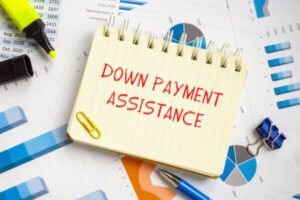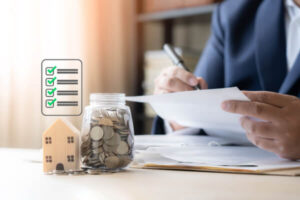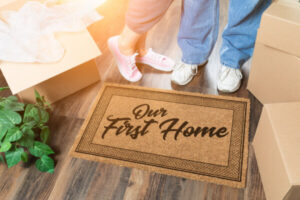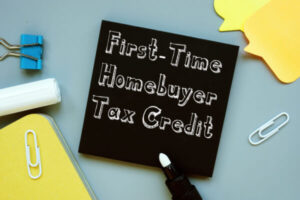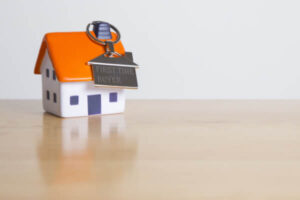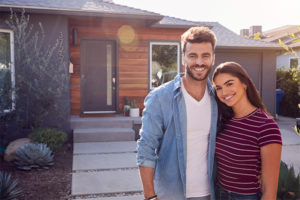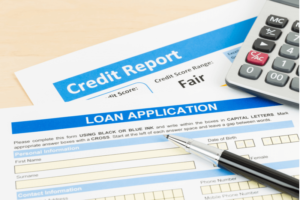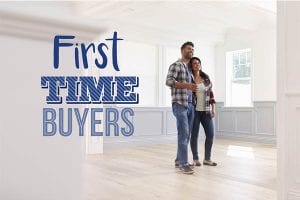The median home price in New York has soared above $400,000 – a chilling prospect for someone considering buying their first home. Coming up with a 20% down payment, or even 5%, may prompt many potential home buyers to throw in the towel.
Lack of down payment keeps 53% of those who want to buy a home from doing so, the National Association of Realtors recently found.
Don’t give up. Home buyers can find down payment assistance in New York through programs that offer grants and loans that cover, or partially defray, the cost. Government-administered, first-time home buyer programs in New York offer first-time home buyer grants – money you don’t have to repay – as well as loans in the form of a second mortgage, with no interest, which are often forgiven if you’re in the home for a certain amount of time. There are more than 68 DPAs in New York, the most common through HomeFirst and State of New York Mortgage Assistance (SONYMA) and often based on Federal Housing Administration (FHA) loan requirements.
Potential buyers who think they don’t qualify as a first-time home buyer or make too much money for a DPA, may be surprised.
What Is a First-Time Home Buyer?
The definition of a first-time home buyer covers a lot of ground. The U.S. Department of Housing and Urban Development’s definition is the guideline for most DPAs.
HUD defines a first-time home buyer as:
- Someone who hasn’t owned a principal residence in the 36 months ending on the date of purchase of the new property.
- A single parent who has only owned a principal residence with a former spouse while married.
- A displaced homemaker who has only owned a principal residence with a spouse.
- An individual who has only owned a principal residence not permanently affixed to a permanent foundation.
- An individual who has only owned a property that was not in compliance with state, local or model building codes and could not be brought into compliance for less than the cost of constructing a permanent structure.
HomeFirst Down Payment Assistance
Qualifying first-time home buyers in New York City can get closing cost and down payment assistance through the HomeFirst Down Payment Assistance Program, which is administered by Neighborhood Housing Services of New York, a nonprofit housing agency.
Benefits
Qualified home buyers can get a loan of up to $100,000 for closing costs or a down payment towards a single-family home, or a condominium or cooperative unit, including multi-family buildings, up to four units. The loan is forgiven if the borrower lives in the property for the required amount of time, otherwise, they have to pay it back upon selling.
Eligibility
Anyone who qualifies as a first-time home buyer is eligible.
- Income Limit – 80% of AMI; in 2024, the limit was $87,100 for a one-person household, $124,400 for four-person
- Purchase Price Limit – Based on units, borough; ranges from $612,000 (one-unit in Manhattan, Staten Island) to $1,343,000 (four-unit in Bronx)
- Credit Score – 620 (580 for FHA mortgages, with lender approval)
- Borrower Cash Contribution – 3%
- Home Buyer Education Course – Required
- Location of Property – New York City
- Required Length of Occupancy– 10-15 years, depending on mortgage amount
Federal Home Loan Bank of New York Home Buyer Dream Program (HDP)
The Federal Home Loan Bank of New York is one of a network of regional lenders created by the federal government after the Great Depression to provide money mortgage assistance money to community banks. FHLBNY provides mortgage support to 103 community banks in New York state. HDP is available to eligible buyers getting a mortgage through the program.
Benefits
HDP provides grants of up to $19,500 to borrowers getting a mortgage through an approved member lender, and $500 toward homeownership counseling. The home may be single-family, condominium, cooperative or manufactured home affixed to a permanent foundation, as well as new construction as long as it’s certified for occupancy by closing. The home can be one to four units.
Eligibility
Buyers must qualify as a first-time home buyer.
- Income Limit – 80% of county AMI
- Purchase Price Limit – None, but the property must not exceed 97% of the appraised value (100% for VA and FHA loans)
- Credit Score – None; Borrower must not exceed 45% debt-to-income ratio
- Borrower Cash Contribution – $1,000
- Home Buyer Education – Required
- Property Location – Anywhere in the U.S
- Required Length of Occupancy – 5 years
SONYMA Down Payment Assistance Loan (DPAL)
SONYMA is a state-administered program that contracts with participating lenders to provide mortgage assistance to low and moderate-income home buyers. Its Down Payment Assistance Loan is available to home buyers who are getting a mortgage through the program.
Benefits
A DPAL is considered a second mortgage with 0% interest and no monthly payment that’s forgiven after 10 years to borrowers in good standing who have stayed in the home. Borrowers who sell the home before that must pay it back when they sell. Loan amounts begin at $1,000 and are capped at 3% of purchase price up to $15,000, or $3,000, whichever is highest.
Eligibility
DPAL is available to SONYMA borrowers who are first-time home buyers, eligible military or buying in a federally designated Target Area.
- Income Limit – Varies by region, SONYMA mortgage type
- Purchase Price Limit – Varies by region
- Credit Score – Varies by lender (good credit required)
- Borrower Cash Contribution – 1% or 3% of the purchase price (depending on property type)
- Home Buyer Education – Required
- Property Location – New York state
- Property Residency – Must be primary residence; length of time varies
- Type of Property – Additional requirements for condominiums, co-ops, New York City
SONYMA Conventional Plus
SONYMA’s Conventional Plus program is for both first-time home buyers and those who already own a home and looking to refinance. It combines a Fannie Mae HomeReady 30-year fixed-rate mortgage and a SONYMA DPAL. It can be used to buy a primary residence or to refinance one.
Benefits
Fannie Mae HomeReady Mortgages require only a 3% down payment. Conventional Plus borrowers can offset the down payment with a DPAL. They can also use the DPAL to pay a higher one-time upfront mortgage insurance premium, which can reduce or eliminate a monthly mortgage insurance payment.
Eligibility
Any first-time homeowner, or existing homeowner who is refinancing may be eligible for a SONYMA Conventional Plus mortgage.
- Income Limit – 80% county AMI. Must run address through Fannie Mae HomeReady Property Eligibility Tool to determine income limits
- Purchase Price Limit – Varies depending on home size; 2024 maximums ranged from $647,200 for single-family to $1,244,850 for four-unit
- Credit Score – 620 (average if there is a co-borrower); 700 if DTI 45% or more
- Borrower Cash Contribution – None single-family, 2%-4% for 2-4 unit
- Home Buyer Education – Required
SONYMA FHA Plus
SONYMA’s FHA Plus program is for both first-time home buyers and those who already own a home and are combining an FHA 30-year fixed-rate mortgage with a DPAL. The property can be a single-family home or condominium that meets FHA loan requirements. It cannot be used for a co-op or manufactured home.
Benefits
Loans backed by the FHA have more flexible down payment and credit score requirements than traditional mortgages. With the SONYMA FHA Plus program, borrowers can partially offset the required 3.5% down payment with a SONYMA DPAL.
Eligibility
First-time homeowners, existing homeowners.
- Income Limit – 80% county AMI
- Purchase Price Limit – Varies depending on region, and units; 2024 FHA average maximums range from $420,680 for one-family in the standard area to $1,867,275 for four-unit in a high-cost area
- Credit Score – 600 (660 for cash-out refinancing)
- Borrower Cash Contribution – 1% of the 3.5% down payment must be from the home buyer; 2.5% may be offset by DPAL
- Home Buyer Education – Required for first-time homeowners, and those with non-traditional credit; landlord education required for multi-unit buyers
Application Process
No matter what first-time home buyer down payment assistance program you’re applying for in New York state, the steps to getting there are the same. Many home buyers’ first step is to look at homes online, find one they like, and then begin the buying process. The better approach is to determine if you are financially ready to buy a home and what type of home you can afford, whether you’ll need a mortgage or down payment assistance. Then the actual buying process can be the final step.
The application process begins well before you fill out the form. Doing the hard work and doing it right will pay off.
The steps to applying for a down payment assistance program in New York are:
- Review your finances: To qualify for a DPA, you’ll need a steady income. Most programs require a two-year history of reliable income that can be verified. Gather your tax forms from the last two years, six months’ worth of pay stubs, and all other income verification. List all your monthly expenses, with account numbers applicable.
- Review your credit: Good credit is a must when applying for DPA. Begin by getting your reports from AnnualCreditReport.com, which will allow you to download reports from the three credit reporting agencies (Experian, Equifax and Transunion). Checking your credit reports, which you can now do for free weekly, will help you in many ways. You’ll know where you stand, see patterns that you may want to reverse, and find and correct errors that may hurt your chances. A solid history of on-time payments, good credit utilization (how much credit you’re allowed vs. how much you’re using), and a good debt-to-income ratio (your monthly payments vs. income) all are factors in having a good credit score.
- Determine what you can afford: Estimate how much of a mortgage you can afford by using SONYMA’s affordability calculator. In general, you want to determine how much you can afford to pay a month. Your monthly payment will be much more than just your mortgage loan divided by 360 payments (12 payments a year for a 30-year mortgage). It includes interest, homeowners’ insurance, property taxes and in many cases private mortgage insurance. It also includes things you may not be considering, like home maintenance, utilities, and possible HOA fees.
- Consider taking a first-time homeowner class: Whether you’re ready to start the application process or have to work more on your finances and credit first, you can benefit from a course that will help you understand the home-buying process. Courses can be found online or in person and generally cost $75-$100, though some nonprofits may offer them for free to eligible candidates. You will benefit even if it’s not your first home-buying experience. Once you complete a course, you receive a certificate that’s good for a certain amount of time. If the course is HUD-approved, you’ll have that step out of the way if you apply for DPA before it expires.
- Find the mortgage down payment assistance program that’s right for you: Take a deeper look at the programs we’ve discussed in this article, as well as others. Decide what can work for you. Traditionally marginalized home buyers, particularly those of color, Native Americans, single mothers and people in economically challenged areas of New York state may find programs specific to them that will help them buy a home.
- Consider pre-approval: It can take from a few weeks to a few months to be approved for a DPA program. If the one you are applying to offers pre-approval, you may want to apply before you start house-hunting, so you’ll be ready to make an offer once you find the home you want to buy. Pre-approval usually has an expiration period, so keep that in mind when home-hunting.
- Find a home: Shop for a home that fits the financial limits you’ve set. Keep in mind that some DPAs are location-specific.
- Apply for downpayment assistance: Once you’ve found a home (or before you do if you plan to get pre-approved), it’s time to apply. Most programs have an online application, but you may also want to visit in person if they offer that option. Applying will mean providing proof of your income, assets, and credit. Find out beforehand what documentation you will need (most list it online). You’ve already gathered this if you’ve done steps 1 and 2, so you may be all set, or may need to fill in some missing pieces. Pay close attention to deadlines and processing times so you will stay on track and not miss anything important. Don’t be afraid to call the toll-free number – they all have one – to talk to someone at the agency if you have questions or need help applying. Remember, it may take a few weeks to a few months for everything to be finalized.
If you aren’t ready for steps 6-8, don’t get discouraged. The journey to getting a mortgage and downpayment assistance is different for everyone, but it starts with taking steps to prepare to do it.
If you still have work to do, find ways to motivate yourself. Make a vision board of the kind of house you want, or put a chart on the refrigerator tracking your down payment savings account or credit score improvement. If you have kids, get them involved. Have them create vision boards and charts as well. If they feel as though they’re part of the process, they’ll be a big help when it comes to saving money and cutting expenses.
Available Resources and Support
No matter what your situation, you are not alone.
Be sure when seeking out resources and down payment assistance programs and information on the internet to keep an eye out for scams. Government programs will have a .gov at the end, not .com. This is particularly true for FHA and VA programs, which are prone to copycat sites.
Some of the available resources and support for first-time home buyer down payment assistance in New York are:
State of New York Mortgage Assistance, SONYMA, has resources for home buyers that go beyond its down payment assistance programs and including counseling services, classes, and workshops.
The Federal Housing Authority (FHA) not only backs mortgage loans for low-income buyers but also provides counseling and a wealth of different kinds of housing programs, including DPA.
The U.S. Department of Agriculture Rural Development Program (USDA) has homeownership programs for buyers in New York’s vast rural areas as well as many suburban ones. They include a zero down payment program for buyers in certain regions, programs for Native Americans, historic preservation grants to renovate older homes and down payment assistance for homeowners who need a safe and healthy home.
U.S. Department of Veterans Affairs (VA) loans, which don’t require a down payment or private mortgage insurance, can be used to buy, build, or improve homes and have lower interest rates than most other mortgages. They are available to most active-duty military and veterans.
The National Home Buyers Fund offers loans and grants that help make homes affordable, including DPA programs, as well as resources and information on home buying.
The Freddie Mac Home Possible program for low-income home buyers offers a downpayment as low as 3% and other resources to make home buying more affordable.
Fannie Mae offers resources, tools, and education on homeownership that helps guide the process for buyers as well as Fannie Mae HomeReady mortgages that require a 3% downpayment.
Individual Development Accounts (IDAs) are offered through state governments and nonprofits to very low-income individuals or qualifying immigrants who have lived in the U.S. for less than five years. They are a pre-tax way to save money for a home (or education, business or car) that provides dollar-to-dollar matching funds.
The U.S. Department of Indian Affairs housing program offers downpayment assistance, as well as grants to improve or buy housing for New York’s Native Americans.
The Seneca Nation Housing Program offers mortgages, down payment assistance, home buyer education, housing improvement grants and resources for the nation’s thousands of citizens in central and western New York, particularly those who don’t live on tribal land.
The New York Mortgage Coalition is a nonprofit collaboration of financial institutions and community housing agencies focused on expanding homeownership for low and moderate-income residents of New York City and its suburbs.
New York City residents can check out the Interboro Community Land Trust, a nonprofit recently set up to provide affordable housing for low-income city residents. It’s a collaboration between the Center for NYC Neighborhoods, Habitat for Humanity New York City, Mutual Housing Association of New York, and the Urban Homesteading Assistance Board. Because it’s a land trust, some down payment assistance programs won’t apply.
Should You Use a First-Time Home Buyer Program in New York?
If you hope to buy a home, either soon or down the road, arming yourself with information on how you can pay for it is essential.
First-time home buyer down payment assistance programs exist not only for the end result – helping you fund the down payment – but can also help you make a plan to buy a home and learn what you need to do to get there.
New York’s SONYMA programs, HomeFirst, the Federal Home Loans Banks down payment assistance program, and other federal and local help, are focused on helping people get over that final financial hurdle that they need to clear to buy a home.
You are in control of your ability to buy a home. Understanding your finances and credit, and how to improve them, are key. Learning about your options and what down payment assistance program is the best fit for you is at your fingertips. There are organizations across New York that can help. As daunting as buying a home may seem, you can do the work and soon be living in the home of your dreams.
HUD-Approved Online Homebuyer Education Course
HomeTrek is an easy-to-use HUD-approved online homebuyer education course. Our course will help you learn budgeting, saving, how to improve your credit, understand home much home you can afford.
Down Payment Assistance Programs in California
Down Payment Assistance Programs in Pennsylvania
First-Time Home Buyer Benefits
What Is the Minimum Down Payment for First-Time Home Buyers?
First-Time Home Buyer Guide
First-Time Homebuyer Tax Credit
First-Time Homebuyer Requirements
Down Payment Assistance Programs in Texas
Credit Scores and the First-Time Homebuyer
First-Time Home Buyers: Programs & Qualifications
Sources:
- N.A. (2024, May 9) Residential median sale price information by county. Retrieved from https://www.tax.ny.gov/research/property/assess/sales/resmedian.htm
- Visali, K. et al (2023, December 7) Expanding Down Payment Assistance Could help More People Afford a Home. Retrieved from https://www.urban.org/urban-wire/expanding-down-payment-assistance-awareness-could-help-more-people-afford-home
- N.A. (2023, September 14) Experiences & Barriers of Prospective Home Buyers: Member Study. Retrieved from https://www.nar.realtor/research-and-statistics/research-reports/experiences-barriers-of-prospective-home-buyers-member-study
- N.A. (ND) HomeFirst Term Sheet. Retrieved from https://www.nyc.gov/assets/hpd/downloads/pdfs/services/homefirst-term-sheet.pdf
- N.A. (ND) Home buyer Dream Program Guidelines 2024. Retrieved from https://www.fhlbny.com/wp-content/uploads/2023/10/HDP-003_2024-Homebuyer-Dream-Program-Guidelines.pdf
- N.A. (ND) Home buyers. Retrieved from https://hcr.ny.gov/homebuyers
- N.A. (2023, November 13) Highlights from the Profile of Home Buyers and Sellers. Retrieved from https://www.nar.realtor/research-and-statistics/research-reports/highlights-from-the-profile-of-home-buyers-and-sellers#financing
- N.A. (2024, April 9) Individual Development Accounts. Retrieved from https://www.acf.hhs.gov/orr/programs/refugees/ida


